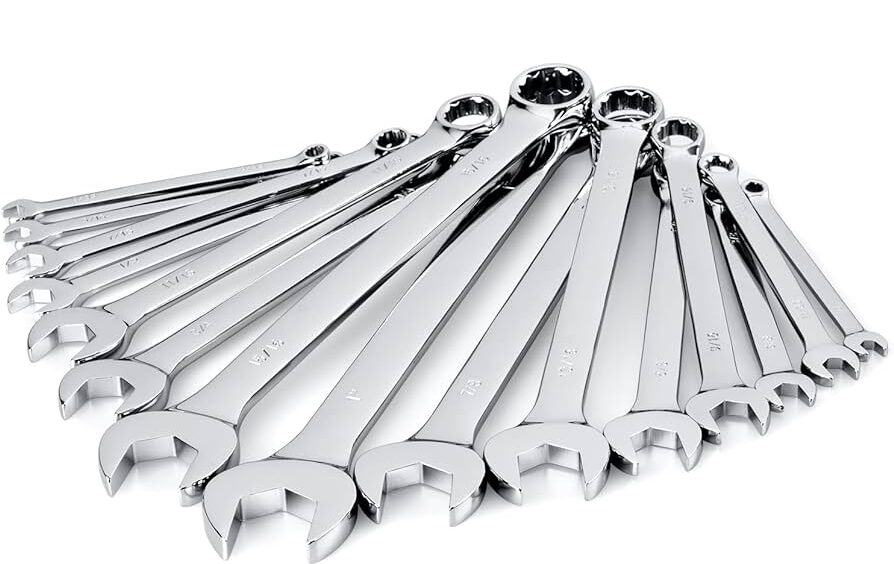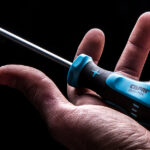Wrenches are essential tools for tightening and loosening nuts and bolts. There are two main sizing standards for wrenches – metric and standard (also known as SAE or Imperial).
Metric wrenches use millimeters (mm) for the size markings. Common metric sizes include 10mm, 12mm, 14mm, 17mm, 19mm, etc. Metric sizes increase and decrease in increments of 1-2mm generally.
Standard wrenches use fractions of an inch for size markings. Common standard sizes include 1/4″, 5/16″, 3/8″, 7/16″, 1/2″, etc. Standard sizes increase and decrease in 1/16″ or 1/8″ increments.
Both metric and standard wrenches are widely used, so it’s helpful to know how to convert between the two. This guide will focus on converting the metric size of 36mm to inches to find its equivalent standard wrench size. Knowing how to convert back and forth allows for using either type of wrench on metric or standard fasteners.
Table of Contents
Metric Wrench Sizes
Metric wrenches are measured in millimeters (mm). Some of the most common metric wrench sizes include:
- 8mm
- 10mm
- 12mm
- 13mm
- 14mm
- 17mm
- 19mm
- 22mm
- 24mm
- 27mm
- 30mm
- 32mm
Metric wrenches follow the ISO standards and come in 1mm increments, making them very precise. The smaller sizes like 8mm, 10mm, 12mm are used on smaller bolts and hardware while the larger sizes are for bigger bolts.
Some key things to know about metric wrench sizes:
- They are measured in mm rather than fractions of an inch.
- The most common sizes range from about 8mm to 32mm.
- Metric wrenches only come in 1mm increments.
- They precisely fit metric bolts and hardware.
- Smaller mm sizes are used for smaller bolts, larger sizes for bigger bolts.
So in summary, metric wrench sizes allow for precise fastening and unfastening of metric hardware and bolts, which are sized in mm as well. The smaller mm sizes fit smaller hardware, while larger mm sizes fit larger hardware and bolts.
Standard Wrench Sizes
Standard wrenches commonly come in fractional inch sizes. The most common sizes are:
- 1/4 inch
- 5/16 inch
- 3/8 inch
- 7/16 inch
- 1/2 inch
- 9/16 inch
- 5/8 inch
- 11/16 inch
- 3/4 inch
- 13/16 inch
- 7/8 inch
- 15/16 inch
Wrenches may also come in numbered inch sizes such as 1 inch, 1 1/8 inches, etc. The fractional sizes are the most widely used though.
Standard wrenches are labeled with the inch size stamped directly on the tool. So a 1/2 inch wrench will be stamped “1/2” on the flat part of the wrench.
The inch sizes refer to the distance between the parallel jaws of the wrench. So a 1/2 inch wrench has a 1/2 inch opening to grip nuts and bolts.
Standard wrenches come in both combination and box end styles. The combination wrench has an open end on one side and a closed box end on the other. The box end provides more grip and torque on the nut or bolt.
36mm Wrench Size
The 36mm wrench size refers to a wrench designed to fit bolts and nuts with a diameter of 36 millimeters. This is a commonly used wrench size for medium to large bolts and nuts.
Some key details about the 36mm wrench size:
- It fits bolt heads and nuts that measure 36mm across flats. This means if you measure across the points of the bolt head or nut, it would be 36mm.
- The opening size of a 36mm wrench is just slightly larger than 36mm to fit over the bolt head or nut. Typically around 36.5mm.
- 36mm wrenches are standard in most metric wrench sets. They provide moderate torque capacity.
- Common uses for 36mm wrenches include automotive applications like axle nuts, drivetrain components, suspension bolts, and more.
- A 36mm wrench can also be used in machinery, construction equipment, bicycles, and other applications using M36 sized hardware.
- The 36mm size fills the gap between smaller 24mm and 30mm wrenches and larger 46mm and 50mm wrenches.
- It’s a versatile medium-duty wrench good to have in any toolbox. Not too large or too small.
So in summary, the 36mm wrench size refers to a tool specifically designed to interface with 36mm hex sized fasteners, a commonly used metric bolt size in many applications. The 36mm size offers useful medium torque capacity.
Converting 36mm to Inches
Converting metric wrench sizes to standard sizes is straightforward using a simple formula. To convert 36mm to inches, we just need to:
- Start with the metric measurement in millimeters (mm). In this case, 36mm.
- Divide the mm value by 25.4. This converts mm to inches because 25.4mm equals 1 inch.
36mm / 25.4 = 1.417322834645669 inches
- Round the resulting number to the nearest 1/16th inch. 1/16th inches are the smallest measurement increment used for standard wrench sizes.
1.417322834645669 rounds to 1 7/16 inches
So a 36mm wrench is equivalent to a 1 7/16 inch wrench in the standard system.
The conversion formula works for any metric wrench size. Just divide the mm value by 25.4 and round accordingly to convert it to the nearest standard fraction of an inch. This provides an easy way to determine the equivalent inch size for metric wrenches.
36mm in Inches
A 36mm wrench is equivalent to a 1 7/16 inch wrench in the standard system. Specifically, 36mm converts to approximately 1.41732 inches.
While metric wrenches are measured in millimeters, standard wrenches use fractions of an inch. 1 inch is equal to 25.4 mm.
To convert from mm to inches, simply divide the mm measurement by 25.4. So for a 36mm wrench:
36mm / 25.4 = 1.41732 inches
The closest fraction to 1.41732 inches is 1 7/16 inches.
So a 36mm wrench is the same as a 1 7/16 inch wrench. Both will fit the same bolt heads and nuts.
When shopping for wrenches, you can look for either a 36mm size or 1 7/16 inches to match this wrench opening. If you have a 36mm bolt head, you’ll need a 1 7/16 inch wrench to fit it properly.
Converting between metric and standard wrench sizes allows flexibility in using both measurement systems. Knowing the right conversion helps ensure you get a properly fitting wrench.
Other Common Conversions
When working with both metric and standard wrenches, there are some other common sizes that you may need to convert between the two systems. Here are some of the most common metric to standard wrench conversions:
- 10mm = 25/64 inches
- 11mm = 7/16 inches
- 12mm = 15/32 inches
- 13mm = 33/64 inches
- 14mm = 9/16 inches
- 17mm = 21/32 inches
- 19mm = 3/4 inches
- 22mm = 7/8 inches
- 24mm = 15/16 inches
- 27mm = 1 1/16 inches
- 30mm = 1 3/16 inches
- 32mm = 1 1/4 inches
Knowing these approximate equivalents can make it easier to substitute a standard wrench when you don’t have the exact metric size available. However, for the most precision it’s best to use a wrench in the correct size for the bolt or nut you are working on. Converting back and forth between metric and standard can introduce small errors that affect the fit.
Usage Tips
When using metric and standard wrenches, it’s important to have the right size for the bolt or nut you are working on. Here are some tips:
- Double check you have the correct wrench size before starting to loosen or tighten a fastener. Trying to use an incorrectly sized wrench can round off fastener heads.
- For metric fasteners, always use a metric wrench. Don’t try to substitute a standard wrench that seems close enough. The sizes are different and you’ll likely strip the bolt head.
- Likewise, only use standard wrenches on standard fasteners. Mixing metric and standard can damage fasteners.
- Use a wrench conversion chart to convert between metric and standard. Keep a printed chart with your tools for easy reference.
- When in doubt, reach for the metric wrench first. Metric sizes are more common in modern equipment.
- Take your time when locating the right wrench size. Rushing increases the chance of using the wrong wrench.
- Replace worn wrenches to minimize fastener damage. A loose fit can round off edges.
- Consider labeling wrenches with size for quick identification if working with multiple sizes.
- Store wrenches properly to avoid damage and rust. Proper care extends useful life.
- Learn to recognize common metric and standard sizes for your application. Familiarity speeds proper wrench selection.
Following these tips will lead to fast and safe use of metric and standard wrenches for all your equipment maintenance and repair jobs. Taking the time to use the proper wrench size prevents fastener and equipment damage.
Conversion Chart
To easily convert between metric and standard wrench sizes, use the following chart:
| Millimeters | Inches |
| 6 mm | 1/4 in |
| 7 mm | 9/32 in |
| 8 mm | 5/16 in |
| 10 mm | 25/64 in |
| 11 mm | 7/16 in |
| 12 mm | 15/32 in |
| 13 mm | 33/64 in |
| 14 mm | 9/16 in |
| 15 mm | 19/32 in |
| 16 mm | 5/8 in |
| 17 mm | 11/16 in |
| 18 mm | 23/32 in |
| 19 mm | 3/4 in |
| 20 mm | 25/32 in |
| 21 mm | 13/16 in |
| 22 mm | 7/8 in |
| 24 mm | 15/16 in |
| 27 mm | 1 1/16 in |
| 30 mm | 1 3/16 in |
| 32 mm | 1 1/4 in |
| 36 mm | 1 7/16 in |
This chart shows the most common metric wrench sizes and their equivalent standard sizes in inches. To use it, simply locate the mm size and find the corresponding inch size in the next column. For example, 36mm converts to 1 7/16 inches. Keep this chart handy for quick reference when working with both metric and standard wrenches.
Conclusion
Converting between metric and standard wrench sizes is straightforward with a simple formula. To recap, here are some final tips:
- The most common metric wrench sizes are 10mm, 12mm, 14mm, 17mm, 19mm, 22mm, 24mm, 27mm, 30mm, 32mm, 36mm.
- The standard system uses fractions of an inch. Common sizes are 1/4″, 5/16″, 3/8″, 7/16″, 1/2″, 9/16″, 5/8″, 11/16″, 3/4″, 13/16″, 7/8″, 15/16″.
- To convert, use the formula: Metric size x 0.03937 = Inches.
- For example, 36mm x 0.03937 = 1.417 inches, which is the nearest standard size of 1 7/16″.
- When converting, round to the nearest standard fraction.
- Keep a conversion chart handy for quick reference.
- Use the right wrench size to avoid stripping bolt heads. Metric and standard wrenches are not interchangeable.
- Take your time when working in an unfamiliar unit system. With practice, converting becomes second nature.
The conversion between metric and standard wrenches is simple math. Following these tips will help ensure you have the right wrench size for the job.



